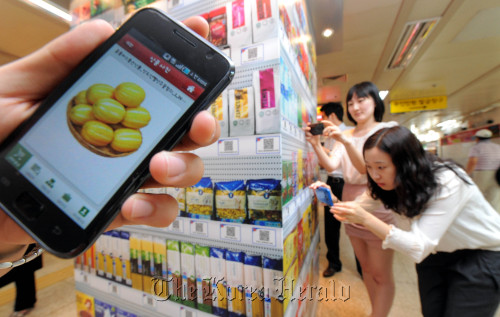While most commuters waiting for trains chat with colleagues, read books or skim advertisements on subway platform doors, smartphone users on the bustling platforms of Seolleung Station in southern Seoul now have a new way to kill time: shopping.
A simple click brings up the images of life-size store shelves or a huge refrigerator plastered on the screen door walls. They are filled with groceries from coffee and crackers to milk, orange juice, apples and even bags of rice. Each item has a small QR code on it, allowing shoppers to scan the codes with their smartphones to order and have the products delivered.
“It’s time-saving, convenient. This will help increase our sales through smartphones, a new growing sales engine,” said Jung Sun-hee, spokeswoman for Homeplus Co., the company behind the virtual stores. “It’s still in infancy, but it has huge potential.”
South Korean retailers have moved quickly to market “smart” ideas that can lure busy smartphone users in the world’s most wired country, which has millions of tech-savvy consumers with more than 15 million smartphones in operation.
If the QR project proves a success at Seolleung Station, it will be expanded to other stations, according to its promoter, Homeplus Co., a South Korean unit of Tesco Plc. and the country’s second-largest discount store.
A simple click brings up the images of life-size store shelves or a huge refrigerator plastered on the screen door walls. They are filled with groceries from coffee and crackers to milk, orange juice, apples and even bags of rice. Each item has a small QR code on it, allowing shoppers to scan the codes with their smartphones to order and have the products delivered.
“It’s time-saving, convenient. This will help increase our sales through smartphones, a new growing sales engine,” said Jung Sun-hee, spokeswoman for Homeplus Co., the company behind the virtual stores. “It’s still in infancy, but it has huge potential.”
South Korean retailers have moved quickly to market “smart” ideas that can lure busy smartphone users in the world’s most wired country, which has millions of tech-savvy consumers with more than 15 million smartphones in operation.
If the QR project proves a success at Seolleung Station, it will be expanded to other stations, according to its promoter, Homeplus Co., a South Korean unit of Tesco Plc. and the country’s second-largest discount store.

“This is one of our projects aimed at letting people shop wherever and whenever they want. And smartphones make it possible,” Jung said. “We are targeting two-worker families too busy to go out for shopping.”
A QR, or quick response, code is a type of matrix barcode designed to take users to a mobile Web page with one tap on the screen to scan it. Most Seoul subway stations are also outfitted with wireless-fidelity networks through which smartphone users can access the Internet for free.
According to Homeplus, its mobile application and Web page have had more than 65,000 users since their launch in April and post an average of 30 million won ($28,000) in sales per week.
Smartphone marketing is also gaining popularity in other sectors such as tourism and publishing.
The Korea Tourism Organization released an English mobile application and a brochure named “Visit Korea QR-Code Book” in February. The app offers foreigners information on South Korea’s tourist attractions, accommodations and transportation. Each section can be also accessed through QR codes printed in the brochure.
So far, over 70,000 iPhone users have downloaded the KTO app.
It ranked second on the “top free list” in April measured by Apple Inc.’s App Store. Its Facebook page and Twitter now have 70,757 and 14,787 followers, respectively, according to the KTO.
“We launched the mobile page and the social network service accounts to improve the country’s visibility and make foreign would-be visitors feel friendly toward Korea,” said Park Hye-ri, part of KTO’s overseas marketing division. “They are very pleased with the easy accessibility and abundant material.”
Publishers are using smartphones as a means to expand the limits of print media.
A book titled “Sima Quin, Dwelling on the Human Way,” published by King’s Library, has a QR code on its front cover that links to a video clip of the author introducing the book. QR codes are also at the beginning of each chapter to encourage readers to see and hear background and other hidden meanings of the text directly from the author.
“It’s really helpful. I just scan the code on my smartphone and see a clip to listen to what the author really wants to say,” said Kim Byung-ki, who bought the book after checking out the video in advance. “I can see the video before buying the book and get a short lecture on the Chinese classic while reading the book.”
Along with QR codes, barcodes, which have been mostly used for storing and checking out products in supermarkets, are now becoming another source of information for consumers. Smartphone users can scan a barcode to get prices, manufacturer and origin of goods.
The Korea Chamber of Commerce and Industry, which controls South Korea’s barcode system, says it receives an average of 20,000 inquiries from shoppers per day.
“These days, consumers want to know more details about a product out of fears about its safety, especially after Japan’s nuclear crisis. And they want to search for much cheaper ones amid recent high inflation,” said Kim Seung-chul, a KCCI official.
“Consumers highly rely on information through smartphones. But if you have wrong information there or manage them poorly, that might tarnish your entire image heavily,” he said.
(Yonhap News)



![[Herald Interview] 'Amid aging population, Korea to invite more young professionals from overseas'](http://res.heraldm.com/phpwas/restmb_idxmake.php?idx=644&simg=/content/image/2024/04/24/20240424050844_0.jpg&u=20240424200058)












![[KH Explains] Korean shipbuilding stocks rally: Real growth or bubble?](http://res.heraldm.com/phpwas/restmb_idxmake.php?idx=652&simg=/content/image/2024/04/25/20240425050656_0.jpg&u=)

